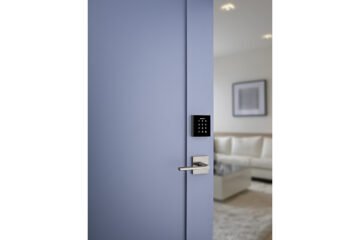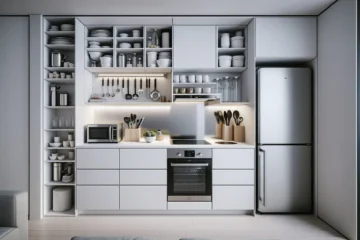The kitchen is often called the heart of the home, and for good reason. With the advent of smart home technology, we now have the opportunity to enhance this space with smart home lighting control system that can dramatically improve both functionality and ambiance.
The Power Of Smart Home Lighting Control System In The Kitchen
Smart lighting goes beyond simply turning lights on and off. It offers a level of control and customization that can transform your kitchen experience. With a smart home lighting control system, you can adjust brightness, color temperature, and even create custom scenes to suit different activities and moods.
- Task Lighting
One of the most important aspects of kitchen lighting is task lighting. This type of lighting focuses on specific work areas, ensuring you have adequate illumination for food preparation, cooking, and cleaning. Smart lighting takes task lighting to the next level by allowing you to adjust the intensity and color temperature to suit your needs.
For example, when chopping vegetables or reading recipes, you might prefer a bright, cool light that mimics daylight. This can help reduce eye strain and improve visibility. On the other hand, when you’re winding down in the evening, a warmer, dimmer light can create a more relaxing atmosphere.
- Ambient Lighting
While task lighting is crucial for functionality, ambient lighting sets the overall mood of your kitchen. Smart lighting systems allow you to create the perfect ambiance for any occasion. Whether you’re hosting a dinner party, enjoying a quiet family meal, or grabbing a late-night snack, you can adjust your lighting to suit the moment.
Key Features of Smart Kitchen Lighting

- Voice Control
One of the most convenient features of smart lighting is voice control. Imagine being able to adjust your kitchen lights hands-free while you’re in the middle of cooking. With compatible smart speakers like Amazon Alexa or Google Home, you can simply say commands like “Alexa, dim the kitchen lights” or “Hey Google, turn on the counter lights”.
- Scheduling and Automation
Smart lighting systems allow you to set schedules for your kitchen lights. This can be particularly useful for energy saving and security. For instance, you can program your lights to turn on automatically in the morning as you start your day, or to turn off at a certain time if you tend to forget.
- Color Temperature Adjustment
The ability to adjust color temperature is a game-changer for kitchen lighting. Cooler temperatures (around 5000K) are great for task lighting during the day, while warmer temperatures (around 2700K) create a cozy atmosphere in the evening. Some smart bulbs even offer a full range of colors, allowing you to add a fun, decorative element to your kitchen.
- Dimming Capabilities
Dimming is an essential feature for kitchen lighting. It allows you to adjust the brightness to suit different activities and times of day. Smart dimmers offer precise control, often allowing you to dim lights to as low as 1% of their full brightness.
Implementing Smart Home Lighting Control System In Your Kitchen
- Smart Bulbs
One of the easiest ways to introduce smart lighting to your kitchen is through smart bulbs. These can be screwed into existing fixtures and controlled via a smartphone app or voice commands. They offer features like dimming, color changing, and scheduling.
- Smart Switches
For a more integrated solution, consider installing smart switches. These replace your existing light switches and can control your regular bulbs, making them “smart.” This option is great if you want to keep your existing fixtures but gain smart control.
- LED Strip Lights
LED strip lights are a versatile option for kitchen lighting. They can be installed under cabinets for task lighting, along kickboards for ambient lighting, or even inside glass-front cabinets for a decorative touch. Many smart LED strips offer color-changing capabilities and can be controlled via smartphone apps.
- Smart Plugs
For lamps or other plug-in lighting fixtures in your kitchen, smart plugs offer an easy way to add smart control. Simply plug your light into the smart plug, and you can control it via app or voice commands.
Creating Lighting Scenes for Different Kitchen Activities
One of the most powerful features of a smart home lighting control system is the ability to create custom scenes. These are pre-set lighting configurations that you can activate with a single command. Here are some ideas for kitchen lighting scenes:
- Cooking Scene
This scene could turn on all task lighting to full brightness, with a cool color temperature for optimal visibility. It might also activate any under-cabinet lighting for additional workspace illumination.
- Dining Scene
For meals, you might want a warmer, softer light. This scene could dim the main lights, turn on any pendant lights over the dining area, and set a warm color temperature for a cozy atmosphere.
- Cleaning Scene
When it’s time to clean up, you’ll want bright, even lighting throughout the kitchen. This scene could turn all lights to full brightness with a neutral color temperature.
- Night Scene
For those midnight snack runs, a night scene could activate dim, warm lighting to guide your way without disrupting your sleep cycle.
Energy Efficiency and Smart Lighting
Smart lighting isn’t just about convenience and aesthetics; it can also lead to significant energy savings. By allowing you to dim lights, turn them off remotely, and set schedules, smart lighting systems can help reduce your energy consumption.
Many smart bulbs are also LED, which are inherently more energy-efficient than traditional incandescent bulbs. Some smart lighting systems even integrate with smart home energy monitors, allowing you to track your lighting energy usage and make informed decisions about your consumption.
Integration with Other Smart Home Systems
The true power of smart lighting often comes from its ability to integrate with other smart home systems. For example:
- Your smart lighting could work with your smart thermostat, adjusting the lighting based on the temperature or time of day.
- Motion sensors could trigger lights to turn on when you enter the kitchen and off when you leave.
- Smart window treatments could work in tandem with your lighting, adjusting based on natural light levels.
Recommended Smart Lighting Product
For those looking to start their smart kitchen lighting journey, the Philips Hue White and Color Ambiance Starter Kit is an excellent choice. This kit includes a Hue Bridge and four color-changing smart bulbs, providing everything you need to begin transforming your kitchen lighting.

The Philips Hue system offers robust features including voice control compatibility, scheduling, and the ability to create custom scenes. The color-changing bulbs allow for both practical task lighting and mood-setting ambient lighting. Plus, Philips Hue integrates with a wide range of other smart home devices, making it a versatile choice for your smart home ecosystem.
In conclusion, smart lighting can significantly enhance the functionality and ambiance of your kitchen. By providing precise control over brightness, color, and timing, smart lighting systems allow you to create the perfect lighting for any kitchen activity. Whether you’re an avid cook, a frequent entertainer, or simply someone who appreciates a well-lit space, smart kitchen lighting can transform your culinary hub into a more efficient, comfortable, and enjoyable environment.


